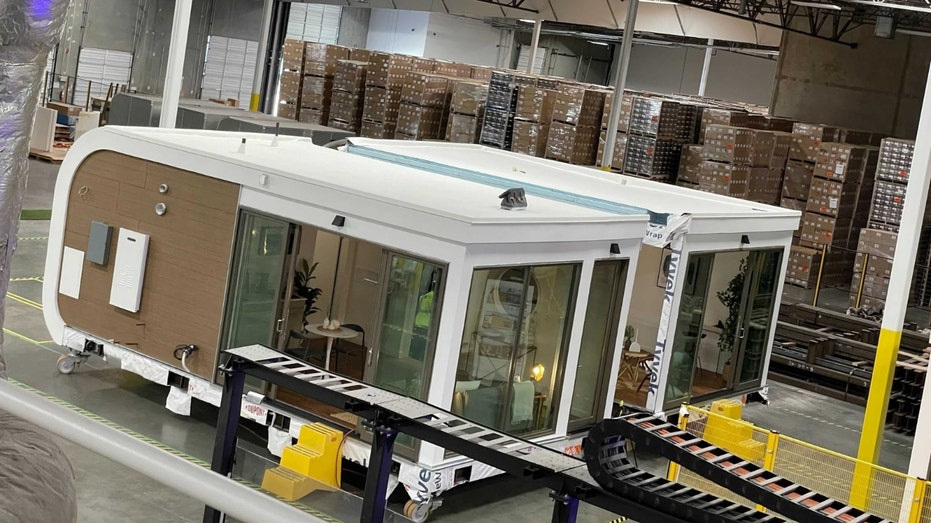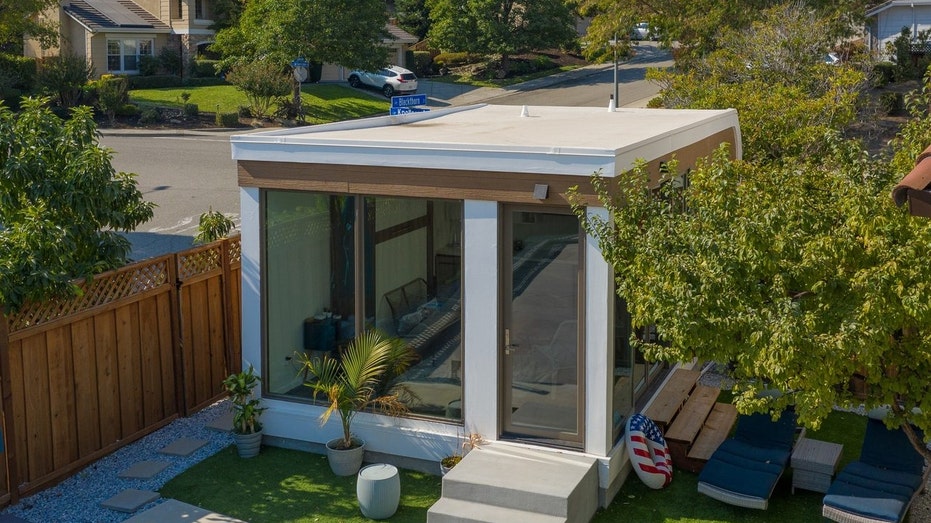Company that makes 3D-printed buildings wants to help solve California housing crisis
The startup's homes cost about 40% less than comparable units
A company that builds 3D homes believes it can be the solution to California's housing crisis.
Mighty Buildings is a 3D construction company incorporated in 2017 and based in Oakland, Calif., shaping the future of the housing market by creating sustainable, functional accessory dwelling units (ADUs) -- similar to "tiny homes" -- using 3D printing technology.
How humans utilize the "building blocks of nature" has always been something that fascinates Mighty Buildings Chief Sustainability Officer Sam Ruben.
SCIENTISTS TRYING TO CREATE HUMAN HEART WITH 3D PRINTER
"We've developed a unique material and printing process," Ruben told FOX Business. "We've taken that idea of layer-by-layer depositing material and combining it with ultraviolet light to [merge] that material."
3D printing, also known as additive printing, is the process of layering material to form solid objects based on digital designs. 3D printing has come a long way over the past few decades; the process can now be used to print organs and body parts, firearms, prosthetics, car parts and homes.
TEXAS COMPANY PLANS TO SELL THE COUNTRY'S FIRST PERMITTED, 3D-PRINTED HOMES
Mighty Buildings' printing process "opens up possibilities of doing things like free-form designs" because material "hardens quickly enough" that structures can support their own weight as they are being built, he explained.
Ruben said Mighty Buildings has been successful on the regulatory front, saying the company's ADUs are compliant with the California Building Code, including Title 24 Energy requirements and other regulatory standards.
RENTAL HOME CONSTRUCTION CLIMBS AS PURCHASE PRICES SURGE
"We've been focused on the regulatory side from the beginning," he said. "We want to do everything we can to develop safety and create standards."
Mighty Buildings does all the permitting, construction and installation work for its customers. Its long-term goal, Ruben said, could look like working with the state of California to help build affordable housing for those experiencing homelessness.
Within the next year, Mighty Buildings is aiming to construct the "largest 3D, single-family, affordable homes in the world."
The startup's homes cost about 40% less than comparable units and are built at a speed about two times faster than traditional construction. Due to the reduced costs and faster construction speeds, the company has the capacity to transform the affordable housing industry.
"Our ADU business directly serving homeowners is only the first step on our journey to help address the housing affordability crisis," Ruben said. "We have already begun to expand into working directly with builders and developers on larger single-family home projects this year and will expand into multi-story next year."
Mighty Building only prints exactly what materials it needs to construct a building.
"Our goal is to decrease labor hours per unit by 90% but increase more work through productivity," Ruben said. "We can do that while having an incredibly sustainable construction site."
The median single-family home price in California reached more than $700,000 in December, and the median single-family condo/townhome price is more than $500,000, according to the California Association of Realtors. The median single-family home price in LA is more than $600,000.
HOME PRICES SURGE BY MOST IN OVER 6 YEARS
The state's rate of housing production is far below what it needs to be, averaging fewer than 80,000 homes constructed per year compared to its projected need of 180,000 new homes annually. Homeownership rates in the state are at their lowest since the 1940s, according to the California Department of Housing and Community Development.
More than 3 million California households contribute more than 30% of their income toward their rent, and more than 1.5 million California households contribute more than 50%. DHC blames increased inequality and opportunities in the state on a lack of supply, rising costs, and fewer jobs in certain areas.
John Robbins, managing director of USA real estate at consulting company Turner & Townsend, told FOX Business that land costs, environmental and zoning requirements, labor costs, other soft costs and market conditions also play into expensive housing costs in California and especially the Bay Area.
Labor costs for a typical housing project, Robbins said, come to about 40% of the total project cost. A union construction worker's pay in the Bay Area is about 45%-60% higher than the national average.

Mighty Buildings Oakland facility (Credit: Mighty Buildings)
He added that there is "no doubt" in his mind that as 3D-printing technology within construction "continues to expand at scale, we will see this being widely adopted for cost, speed, quality, environmental and sustainability reasons, versus traditional stick building."
"There is 3D happening at smaller-scale, mostly single-unit dwellings, but it’s just a matter of time," he said.
He continued: "One of the biggest impediments currently is the regulatory requirements around entitlement issues, codes, etc. Many municipal jurisdictions have not gotten completely on board yet with modular building, but we are starting to see it more widely adopted. Probably up to 20% less expensive, but as time goes on and processes more efficient, the cost savings side could rise dramatically."
Ruben said that because of Mighty Buildings' "efforts to engage with regulators since early on" in the company's existence before it started delivering buildings in 2020 and after it received "initial approval from California HCD in late 2019," it has "had minimal issues on that front other than the standard delays in local permitting which were exacerbated by the onset of COVID."
Mighty Buildings is "the first and to date only company [or] technology to be certified" under a 3D-printing standard that it worked to create with Underwriters Laboratories (UL), a global safety certification company.
The U.S. has seen year-over-year increases in homelessness continually since 2010. California recorded a 16% rise in homelessness between 2018 and 2019, and it saw individual homelessness expand 21% between 2019 and 2020, according to a January 2020 Department of Housing and Human Services report.
California has more than 108,000 unsheltered homeless people, more than half the number in the entire country, HUD found. That's nearly nine times the comparable population in Florida, which ranks just behind it.
Ruben added that Mighty Buildings, which currently has 60 units "on the ground," has plans to expand to other states in coming years.
Pricing for Mighty Buildings' units starts at around $113,000 -- not including site work and delivery -- for its 350-square-foot studio unit, which includes kitchen cabinetry and appliances, a washer and dryer and HVAC. A two-bedroom, one-bathroom unit starts at about $290,000.
The cost to build an affordable housing unit under the Low-Income Housing Tax Credit (LIHTC) rose from $425,000 per unit in 2016 to more than $480,000 per unit in 2019 -- a 13% increase, a March report from the Terner Center for Housing Innovation at the University of California Berkley.
"To make substantial progress in addressing California’s housing crises, we need to make significant changes in state and local policy to promote more building and the private sector needs to innovate to reduce the cost of construction," Michelle Boyd, Housing Lab program director at the Terner Center for Housing, told Fox News.
She added that "3D printing offers a promising pathway to reduce construction costs, especially for small homes, but the full potential of this technique has yet to be realized."
CALIFORNIA GIRL RAISES $32G FOR HOMELESS MAN WHO FOUND, RETURNED GRANDMOTHER'S WALLET
"In addition, we need innovation across the production process for multifamily housing -- including modular, panelized, and component-based production -- to reduce costs enough to affect the housing shortage," she said.
Mighty Buildings wants to have "factories around the world," create "new jobs for different markets and "attract a whole new generation of workers," Ruben said.
"Our vision is a distributed network of Mighty Factories deployed across the country and globe to serve local markets where we have demand/partners," he said. "To this end, we are already in advanced conversations with developers/builders in other regions of the country and world."
Sara Prada, a mother of three and small business owner, hired Mighty Buildings to create a studio home on her property so she could have her own office space outside of her main home.
Prada, who was also recently elected to her local school board, owns "Sara Marie Photography" and specializes in newborn and family portraits.

Mighty Buildings (Credit: Mighty Buildings)
Prior to owning a Mighty Buildings home, Prada worked out of a rented studio space and then out of her own home for a short period, but the inconvenience of transporting materials back and forth to a rental studio space and bringing clients into her own home for sessions wasn't working out.
The COVID-19 pandemic heightened her stress as some aspects of her work became remote and her children stayed home for online learning.
GET FOX BUSINESS ON THE GO BY CLICKING HERE
Her work "involves a lot of conversations, which can be stressful with three kids, a dog and a cat at home," she told Fox Business.
"I decided I wanted to get a unit outside our building," she said. Her husband found Mighty Buildings after doing some research, and Prada loved the company's mission.
She described her studio as "beautiful," with an open kitchen, a washer and dryer, a bedroom area that she plans to use for her portrait sessions and a sliding door. She also plans to add a deck to the structure.
CLICK HERE TO READ MORE ON FOX BUSINESS
Prada praised Mighty Buildings' "communication," "flexibility" and the contractors the company partners with. Her only criticism was a miscommunication that led the company to deliver the wrong building at first, but they quickly fixed the problem.
"I feel like their company is learning," she said. "We’ve had a lot of trial and error with them, but I see where they made progress."





















